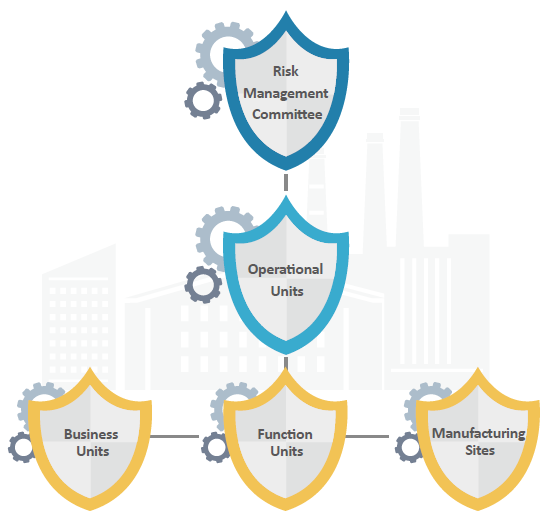
Operation and Governance
Enterprise Risk Management
To ensure sustainable business achievements, USI organized a Risk Management Committee to execute annual risk management activities according to business environment, industrial trend, and company operations.

Through worldwide manufacturing sites, business units and function units, USI engages Enterprise Risk Management (ERM) project to identify risk events and factors, evaluate and adopt proper countermeasures to ensure sustainable management and achieve business operational goals.
USI’s ERM process includes:
1. Identify corporate level and operational level risks, list various risks that are facing by corporate and conduct top-down ERM approach by top managements to confirm the focused items.
2. Conduct bottom-up ERM approach by operation units to check their management risks, inspect internal and external risk factors, and show the control results on risk map according to the evaluation of Risk Level and Control Effectiveness.
3. Generate a corporate risk report based on risk evaluation results from operation units and corporate level. Inspect risk situations, countermeasures and corporate opportunities. List corrective actions and risk mitigation plans for the risk items identified by each operation unit. For any risk whose frequency of occurrence is hard to be predicted, such as climate change or an economic recession under external environment risks, the assessment shall focus on the likely impact of such risk event rather than considering the occurrence frequency.
4. Monitor quarterly progress of risk mitigation plans to ensure the risks are effective controlled, and convert the corporate risk management to the effective behaviors of organization strategies enhancement.
ERM Process:

As global risks continue to rise, if a factory is damaged or ceases operation due to hazardous risks, it may reduce production capacity and lead to the loss of important customers, and have a significant adverse impact on the company's operations and financial performance. By implementing a Business Continuity Management System (BCMS), an organization can increase its resilience and ability to recover from disruptive events, and develop plans and procedures to ensure the continuity of its operations in the event of a disruption.
Business Continuity Management Policy
- USI's operation management shall have risk awareness, and integrate risk management into the business strategy and organizational culture to meet the commitment of applicable requirements.
- Establish a management and risk response mechanism for identification, assessment, and control of major risks, and perform business impact analysis in accordance with operational objectives to establish business continuity objectives, strategies, and plans, and continue to improve. Embed crisis management into employees' awareness and skills and conduct regular drills to ensure effectiveness.
- Openly and actively communicate risk information with stakeholders.
|
BCMS Milestones |
2022 KPIs | 2026 Objectives |
|---|---|---|
| Nantou Plant Passed ISO 22301 Verification | Introduce BCMS to worldwide critical sites |


